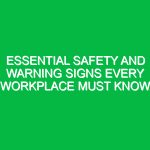Introduction
Safety assessments are a cornerstone of the Health, Safety, and Environment (HSE) domain. These evaluations serve as systematic processes that identify potential Hazards, assess risks, and implement measures to mitigate them. In an era where Workplace Safety and environmental preservation are paramount, understanding the intricacies of Safety assessments is essential for organizations striving to uphold their legal obligations and ethical responsibilities. This article delves into the significance of Safety assessments in HSE, exploring their key components, methodologies, and the Regulations that govern them, ultimately illuminating their role in fostering a culture of safety and Sustainability.
The Importance of Safety Assessments in HSE
Safety assessments play a critical role in the HSE landscape for several reasons:
- Risk Identification: They help identify existing and potential Hazards within a workplace or project.
- Risk Mitigation: By assessing risks, organizations can implement effective Control Measures to reduce incidents.
- Compliance: Safety assessments ensure adherence to legal requirements and industry Standards.
- Enhanced Safety Culture: Regular assessments promote a proactive safety culture among employees.
- Cost-Effectiveness: Effective safety assessments can lead to reduced costs associated with accidents and regulatory fines.
By conducting thorough safety assessments, organizations can not only protect their employees but also enhance their operational efficiency and reputation.
Key Components of Safety Assessments
Understanding the essential components of safety assessments is crucial for their effective implementation. Here are the key elements:
1. Hazard Identification
The first step in any safety assessment involves identifying hazards. Hazards can be physical, chemical, biological, ergonomic, or psychosocial. For example, in a manufacturing plant, moving machinery poses a physical hazard, while exposure to chemicals may represent a chemical hazard. Engaging employees in this process is vital, as they are often the most familiar with potential risks in their work environment. For instance, during a recent safety assessment at a chemical processing facility, workers identified previously overlooked risks related to unguarded machinery, leading to significant improvements in safety protocols.
2. Risk Assessment
Once hazards are identified, the next step is to assess the associated risks. This involves determining the likelihood of a hazard causing harm and the severity of the consequences. Organizations often use qualitative or quantitative methods to evaluate risks. A simple qualitative assessment might categorize risks as low, medium, or high, while quantitative assessments may involve statistical data. For example, a construction site may assess the risk of falls from heights by analyzing past incident data and the effectiveness of existing Safety Measures.
3. Control Measures
After assessing risks, organizations must develop and implement Control Measures to mitigate identified hazards. Control measures can include engineering controls, administrative controls, and Personal Protective Equipment (PPE). For instance, in a warehouse setting, installing guardrails and safety nets can significantly reduce the risk of falls. Furthermore, training employees on proper lifting techniques can mitigate ergonomic risks.
4. Monitoring and Review
Safety assessments are not a one-time event; they require ongoing monitoring and periodic review. Organizations should regularly evaluate the effectiveness of implemented control measures and adjust them as necessary. For example, after implementing a new safety protocol, a manufacturing company conducted follow-up assessments that revealed areas for improvement, such as additional employee Training on machinery Operation.
Benefits of Conducting Safety Assessments
The Benefits of conducting regular safety assessments extend beyond mere compliance. Here are some of the most significant advantages:
- Improved Employee Morale: Employees who feel safe at work are more likely to be productive and engaged.
- Reduced Accidents and Injuries: Effective safety assessments lead to fewer workplace incidents.
- Enhanced Reputation: Organizations known for their commitment to safety attract better talent and clients.
- Financial Savings: Decreased incidents lead to lower insurance premiums and less downtime.
- Regulatory Compliance: Regular assessments help organizations stay compliant with laws and regulations.
These benefits underscore the necessity of integrating safety assessments into an organization’s operational strategy.
Best Practices for Conducting Safety Assessments
To optimize the effectiveness of safety assessments, organizations should adhere to Best Practices:
1. Involve Employees
Engaging employees in safety assessments is vital. They provide valuable insights into potential hazards and the effectiveness of control measures. Conducting workshops or focus groups allows employees to share their experiences and suggestions.
2. Use a Structured Approach
A systematic approach to safety assessments ensures that no critical aspect is overlooked. Utilize established frameworks such as the Plan-Do-Check-Act (PDCA) method to guide the assessment process.
3. Document Everything
Proper documentation is essential for tracking progress and demonstrating compliance. Maintain detailed records of all assessments, findings, and actions taken. This documentation can be invaluable during audits or inspections.
4. Provide Training
Training employees on safety protocols and the importance of safety assessments fosters a culture of safety. Regular training sessions can keep safety at the forefront of employees’ minds and encourage proactive behavior.
Identifying Hazards and Risks
In the context of safety assessments, recognizing hazards and understanding associated risks is critical. Hazards can arise from various sources, including machinery, chemicals, or even organizational practices. Below are common categories of hazards:
- Physical Hazards: Includes slips, trips, falls, and exposure to machinery.
- Chemical Hazards: Involves exposure to harmful substances, such as toxic chemicals or fumes.
- Biological Hazards: Pertains to exposure to bacteria, viruses, or other pathogens.
- Ergonomic Hazards: Relates to repetitive strain injuries and poor workstation design.
- Psychosocial Hazards: Encompasses workplace stress and violence.
Each category requires specific attention and tailored control measures to effectively mitigate risks.
Regulations and Standards Governing Safety Assessments
Adhering to regulations and standards is crucial for ensuring the effectiveness of safety assessments. Various regulatory bodies set forth guidelines that organizations must follow. Some notable regulations include:
1. Occupational Safety and Health Administration (OSHA)
In the United States, osha sets forth regulations that encompass safety assessments. Employers are required to conduct hazard assessments and ensure a safe working environment. Failure to comply can result in severe penalties.
2. ISO 45001
This international standard provides a framework for Occupational Health and safety management systems. It emphasizes the need for continual improvement and worker participation in safety assessments.
3. Environmental Protection Agency (EPA)
The EPA regulates environmental hazards, requiring organizations to assess the impact of their operations on the environment. Compliance with EPA regulations is essential for sustainable business practices.
Understanding how these regulations impact safety assessments is vital for organizations aiming to maintain compliance and promote safety.
Conclusion
In conclusion, safety assessments are an indispensable aspect of the HSE domain. They not only protect employees and the environment but also enhance organizational efficiency and reputation. By implementing systematic safety assessments that involve employee participation, utilize structured approaches, and comply with regulations, organizations can cultivate a culture of safety and sustainability. As we move forward, let us recognize the importance of these assessments in our workplaces and commit to continuous improvement in health, safety, and environmental practices. The journey towards a safer and more sustainable future begins with a single assessment.


